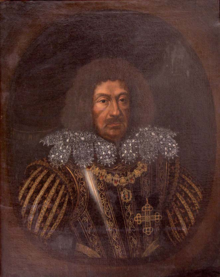Order of knights of the Christian militia

The order of the Christian militia took two attempts to come into being.
history
The first foundation by the Petrinagni brothers was an attempt to establish an Italian order. The papal blessing and the attempt to spread it in France and Germany can be seen as a failure. Only the second attempt at a foundation by the order of knights was successful. The purpose of the order was to fight against the Turks in the Mediterranean area and to drive them out.
The final foundation was made by Karl I von Gonzaga , Duke of Nevers and with Michael Adolf Graf von Althann . These nobles agreed to meet in Olomouc on November 6, 1618 to set up a new one different from the Italian order on March 8, 1619 in Vienna . The new purpose was the liberation of the "unbelieving oppressed and the promotion of unity among the Christian princes". It was the reception organization for Greek volunteers and the core of a European army.
In the initial phase, many Germans, Italians, French and Poles joined the Duke of Mantua Ferdinando I von Gonzaga, who later joined one of the Petrinagni brothers .
The order also became known under the title Order of the Glorious, Immaculate Conception of the Blessed Virgin Mary under the Rule of St. Francis and under the protection of St. Michael the Archangel and St. Basil . The Pope Urban VIII. , Issued the confirmation and blessing 1623. The Count Althann wanted to basically be called the members of the Order, the male heir Michael and Maria female after his change of religion. The order fell into disrepair with the death of the founder, Duke of Revers.
Order decoration
The order decoration was a gold, eight-pointed, blue enameled cross. On the front of the medallion was the image of the Blessed Virgin Mary with the baby Jesus., The back showed the image of St. Michael.
Ribbon and way of wearing
The blue ribbon had a gold border. The cross was worn around the neck as a neck medal. This included a religious dress. The knights wore a mantle with a gold embroidered star on the left side.
Individual proof
- ^ Heinz Gollwitzer, History of World Political Thinking (From the Age of Discovery to the Beginning of Imperialism); Vandenhoeck & Ruprecht, 1972, p. 80
literature
- Ludwig Kuhn, Handbook of the history and constitution of all flourishing knight orders in Europe, Camesinasche Buchhandlung Vienna 1811, p. 130 ff. ( Digitized version )
- Johann Georg Krünitz, Economic (economic-technological) encyclopedia, or general system of rural, domestic and state economics, Joachim Pauli bookstore, Berlin 1817, p. 398